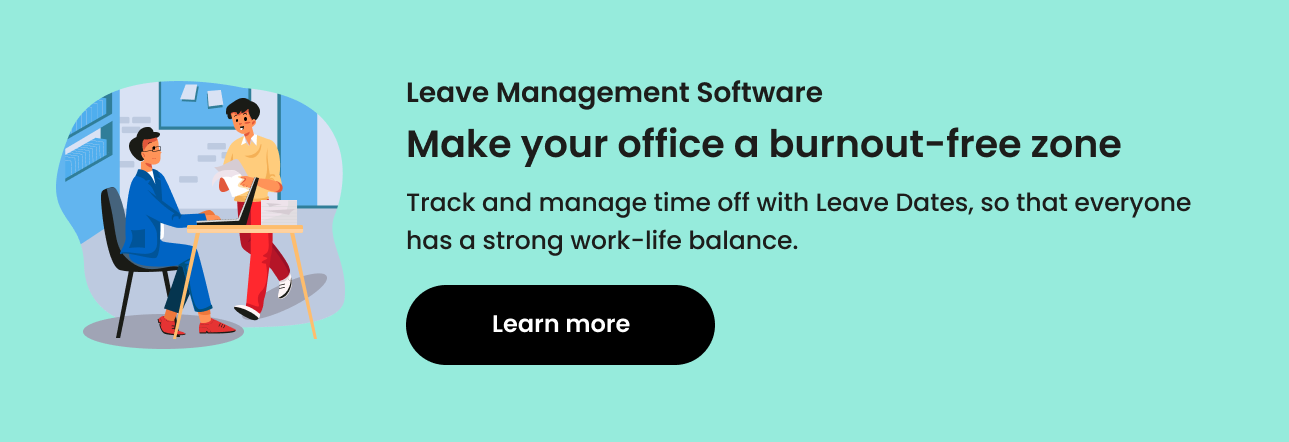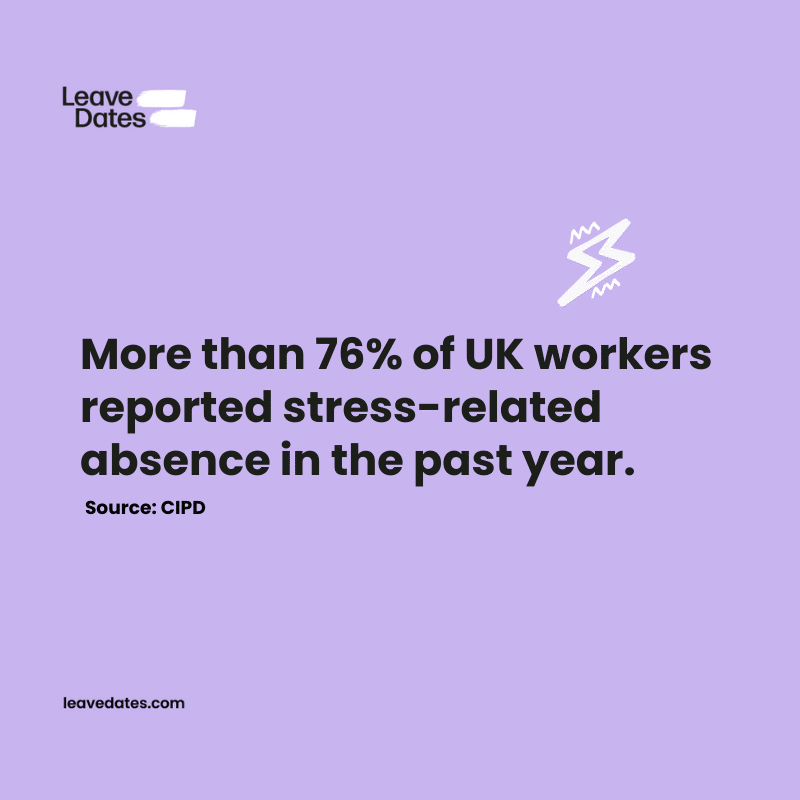
The words ‘work’ and ‘stress’ are so often spoken in the same breath that, for many, they’re basically the same thing. One inevitably invites the other. But does it have to be this way? After all, what’s the point of all our new technology if we’re not making it easier for us to work less, to work smarter, to – dare we say – enjoy work?
Table of Contents
- What are Employee Assistance Programmes (EAPs) and how do they work?
- EAPs for stress management
- Fostering a positive work environment
- Strategies for encouraging EAP utilisation
- How to choose a provider and measure success
- Key takeaways
At Leave Dates, we don’t believe work is inherently stressful. Stress is a sign that something is out of balance – whether that’s the culture, the workflow, the resourcing, whatever. Something is up, and needs to be fixed.
Of course, being stressed at work doesn’t mean the stress has come from work. Just as we’ve all had a rubbish day at the office and taken that bad mood home with us, tricky stuff at home doesn’t vanish from our minds the minute the clock strikes 9 on Monday morning.
Whatever and wherever the cause, stressed employees are less likely to be productive and more likely to burn out, neither of which are great for business or for people.
So what can employers and managers do about it?
What are Employee Assistance Programmes (EAPs) and how do they work?
EAPs are company-sponsored initiatives designed to help employees deal with problems that might harm their health and wellbeing and, in turn, their work performance. They usually consist of a range of services, like counselling, workshops and resources, all aimed at supporting people through various challenges. Chief among the battles we all seem to face at one point or another, is stress and burnout.
EAPs offer benefits galore, for employees and employers alike. For the staff, access to things like confidential counselling can be a huge help in working through personal and professional challenges. Bosses and line managers must know that they are often the very last people a struggling team member wants to confide in about something that’s holding them back at work – it might even be about them.
Whether it’s a confidence boost or a safe space they’re looking for, EAPs provide a way for staff to seek help without fear of judgement or repercussions. The culture of openness and support this creates can only be a good thing.
For employers, the case is just as compelling. No business can function at its best with distracted, unhappy, stressed or burned-out staff. By providing tools to prevent or alleviate such issues, organisations will see higher productivity and lower sickness absence. Both of which will directly impact their bottom line.
From a wider view, investing in employee wellbeing shows commitment to and respect for your people, and the positive work environment it creates will attract – and retain – top talent.
EAPs for stress management
When it comes to managing stress and avoiding burnout, EAPs play a crucial role in identifying, assessing and fixing these issues in the workplace. Spotting the early signs of burnout is key to nipping it in the bud before it becomes a severe or chronic issue. Signs and symptoms of a problem can include:
- Fatigue
- Low motivation and/or engagement
- Cynicism
- Feelings of detachment towards work
When you can clock these signs early, targeted interventions through EAPs can help people to avoid or recover from burnout more quickly. These might be work-life balance coaching, conflict resolution, stress-management tools and self-care practices.
Fostering a positive work environment
Beyond individual-level support, EAPs help to foster a positive work environment overall by promoting a culture of mental health awareness and support. When struggling isn’t seen as taboo, or a sign of weakness, people will be more vocal about it and more likely to seek help before things reach crisis point.
EAPs can be used to educate employees about the importance and impact of mental health at work, reducing stigma and prompting dialogue around things that people might otherwise suffer in silence with. Rare is the problem that goes away when it’s ignored, and things are usually less scary once they’re out of our heads.
Open communication might also reveal that more than one person is facing the same challenge, or connect people with others who have the resources or experience to help.
Strategies for encouraging EAP utilisation
Of course, all these great benefits only exist in theory if you have EAPs that no one knows about, or people aren’t using. Until we move entirely past the stigma around mental health struggles and the toxic ‘hustle’ culture, we still need to take an active approach to promoting uptake of EAPs.
There are various ways you can build awareness and encourage use of your EAP:
- Communication. Be sure to talk often about EAP services and their use across all levels of the organisation, through newsletters/emails, intranet promotion and new staff induction.
- Leadership buy-in. Leaders and managers should shout about the importance of mental health and lead by example, making use of the EAP themselves and signposting it to others.
- Anonymous feedback. Ensure the services and resources the EAP provides are relevant and targeted towards the actual needs of your people. Ask for their opinions, then listen and respond!
How to choose a provider and measure success
Most employers will bring in an external provider for their EAP, rather than design, build and deliver one themselves. This is ideal for various reasons, not least the impartiality and confidentiality this kind of detachment ensures. If people think their boss is going to have access to their deepest fears, private info and professional anxieties then uptake will likely be… limited.
But who to choose? And what to look for? There are so many factors to consider, from range of services, accessibility, availability and of course, cost. The EAP association have some great accredited options to choose from, but there are a lot of factors to look at. Integration of EAP services into the HR framework you already have is a big thing to look for, as this will ensure easy access and so maximise results.
Once you have chosen and embedded an EAP, you can’t just cross it off your to-do list and forget about it. Not if you want to see maximum impact, anyway. Like any new business tool, you will want to measure its success.
In this case, the key metrics to look for are absenteeism rates, productivity levels and employee engagement. You should already have systems in place to measure these, so the impact of your EAP will be clear to see within a few months.

You can also gather feedback direct from your staff, in the form of surveys, focus groups or just informal chats to gauge how happy they are with the EAP services and spot any areas you can improve on.
Key takeaways
For the engaged employer, making wellness a top priority is not just a moral imperative but a strategic advantage. Healthy people make for healthy businesses. You can’t switch between two modes of being – or at least not for long. If you’re not happy and healthy in life, you won’t be happy and healthy at work. This is not what we want.
There’s no point trying to hold back the wave of stress and keep going until Friday – like it or loathe it, work is a big part of most people’s lives and should not be treated as something that exists separately from us. Stress doesn’t care about working hours or weekends; it filters down into everything we do and can be completely debilitating for people and for businesses. Prevention is always better than cure, but lucky for us we have more tools than ever to help people juggle the demands of modern life.
EAPs are a valuable weapon in that arsenal, providing a holistic approach to stress management that empowers people to cherry pick the support they need, when they need it. In this way, they help people to not just survive but also thrive in the demanding business environment we now find ourselves in, and to build resilience for the many changes surely coming our way in the years to come.
Remember: EAPs are not a panacea to a poor work culture where stress is the norm. They should not be seen as a counterbalance to a pace or burden of work that is unsustainable. What they are is a fantastic tool to support your staff to be their best selves and to enjoy their work. By putting your money where your mouth is in promoting wellbeing and looking after your people, you signal that you are a caring employer that wants people not robots.



